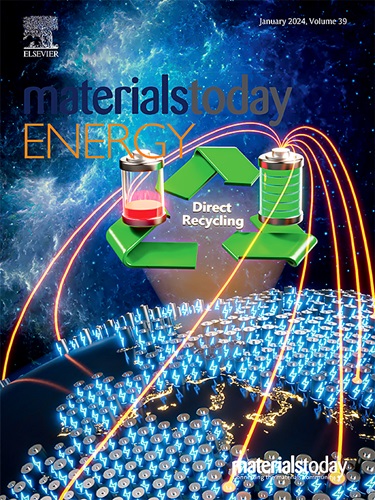具有分层供体分布和合金受体的形态工程多组分有机太阳能电池,可提高效率和稳定性
IF 8.6
2区 材料科学
Q1 CHEMISTRY, PHYSICAL
引用次数: 0
摘要
在有机光伏(OPV)的大块异质结层中集成多种成分的策略已被证明能有效提高设备性能,并具有广泛的应用潜力。然而,在这样一个多元系统中实现对形态的精确控制是一项重大挑战。在这项工作中,我们引入了一种创新的连续浇铸技术来制造高效的四元 OPV,该技术具有精心定制的形态,其特点是分层分布的供体层和复合合金受体层。D18/PTQ10 的分层结构具有明显的结晶域,建立了专用的空穴传输通道,而合金化的 BTP-eC9:Y6-O 受体则均匀地分散在分层的 D18/PTQ10 供体相中。这种精心制作的形态在理想的长度范围内呈现出梯度和互穿的供体/受体相分离,有利于激子解离,最大限度地减少能量无序,并减轻重组。因此,实现了接近 19% 的功率转换效率和出色的运行稳定性(推断 = 818 小时)。这项研究为提高多组分 OPV 性能的形态工程提供了宝贵的见解。本文章由计算机程序翻译,如有差异,请以英文原文为准。
Morphologically Engineered Multi-component Organic Solar Cells with Stratified Donor Distribution and Alloyed Acceptors for Enhanced Efficiency and Stability
The strategy of integrating multiple components within the bulk-heterojunction layer of organic photovoltaics (OPVs) has proven effective in enhancing the device performance and demonstrates broad potential applications. Nonetheless, achieving precise control over the morphology in such a multifaceted system presents a significant challenge. In this work, we introduce an innovative sequential casting technique to fabricate highly efficient quaternary OPVs, with a meticulously tailored morphology featuring layers of stratified donor distribution and composite alloyed acceptors. The layered configuration of D18/PTQ10, with distinct crystalline domains, establishes a dedicated hole-transport pathway, while the alloyed BTP-eC9:Y6-O acceptors are evenly dispersed across the layered D18/PTQ10 donor phase. This carefully crafted morphology presents a gradient and interpenetrated donor/acceptor phase separation at an ideal length scale, which facilitates exciton dissociation, minimizes energetic disorder, and mitigates recombination. As a result, a power conversion efficiency close to 19% with excellent operational stability (extrapolated =818 h) was achieved. This work offers valuable insights into the morphological engineering of multi-component OPVs for improved performance.
求助全文
通过发布文献求助,成功后即可免费获取论文全文。
去求助
来源期刊

Materials Today Energy
Materials Science-Materials Science (miscellaneous)
CiteScore
15.10
自引率
7.50%
发文量
291
审稿时长
15 days
期刊介绍:
Materials Today Energy is a multi-disciplinary, rapid-publication journal focused on all aspects of materials for energy.
Materials Today Energy provides a forum for the discussion of high quality research that is helping define the inclusive, growing field of energy materials.
Part of the Materials Today family, Materials Today Energy offers authors rigorous peer review, rapid decisions, and high visibility. The editors welcome comprehensive articles, short communications and reviews on both theoretical and experimental work in relation to energy harvesting, conversion, storage and distribution, on topics including but not limited to:
-Solar energy conversion
-Hydrogen generation
-Photocatalysis
-Thermoelectric materials and devices
-Materials for nuclear energy applications
-Materials for Energy Storage
-Environment protection
-Sustainable and green materials
 求助内容:
求助内容: 应助结果提醒方式:
应助结果提醒方式:


